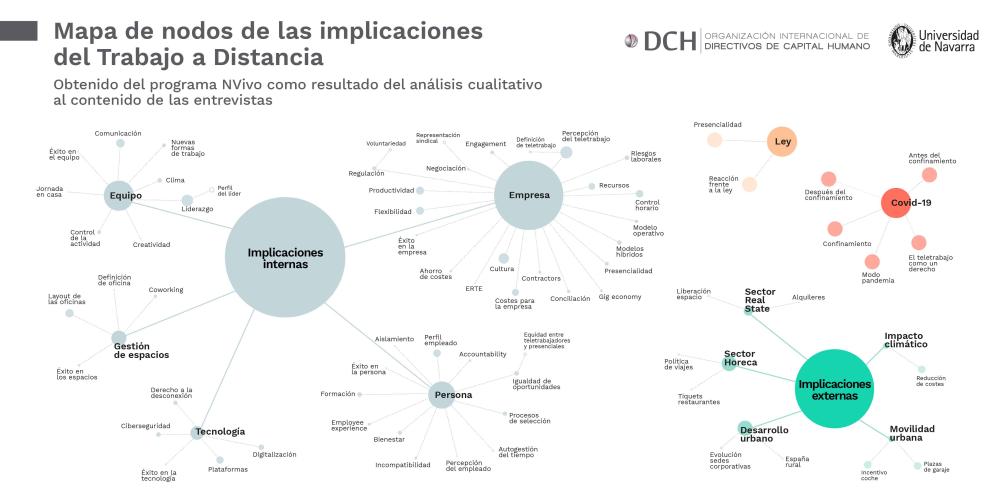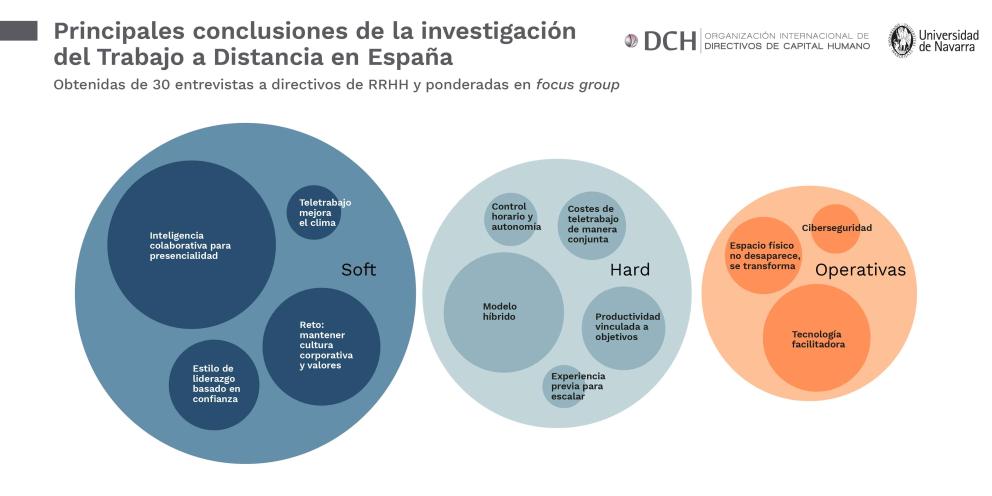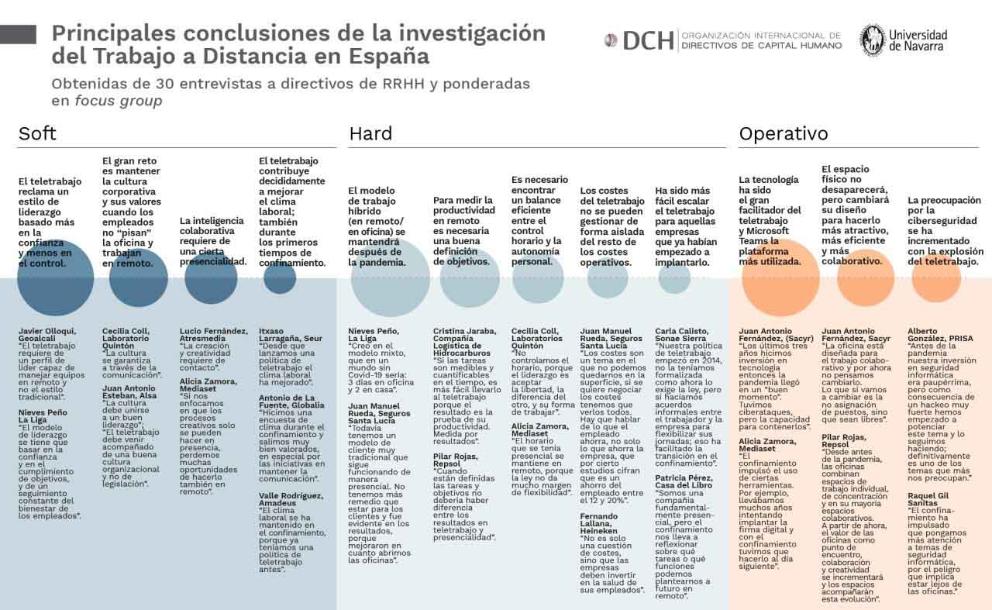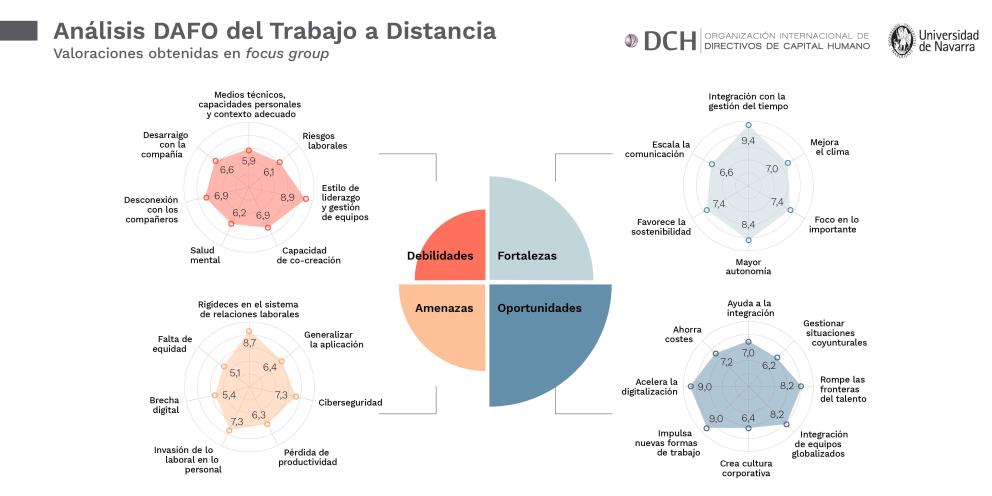DESIGN ORGANIZATIONAL AND ENVIRONMENT / ROCÍO DEL PRADO
Experts from the University of Navarra and the Organización de Directivos de Capital Humano (DCH) present the main conclusions of the qualitative research carried out after interviewing 30 Human Resources managers in Spain, and calibrated in a focus group with 15 members of the DCH committee advisor .
"Telework is a systemic change in the way of developing the work and affects all aspects of the business and the person" says Alberto Andreu, academic director of the Master's Degree Executive in Human Resources and Digitalization. However, it is the "soft" elements of telework that most concern organizations in the process of implementing telework.
According to the conclusions of the publication, in the "soft" field, teleworking calls for a leadership style based on trust and not so much on control, and also contributes decisively to improving the work environment. However, collaborative intelligence requires a certain degree of presence and managers say that the great challenge lies in maintaining the corporate culture and values when employees do not go to the office.

On the "hard" side, the hybrid work model (remote/office) will be maintained after the pandemic. Therefore, measuring remote productivity will require a good definition of objectives. The research also reveals that an efficient balance must be found between schedule control and staff autonomy. However, the costs of remote work cannot be managed in isolation from other operating costs. And among all the companies, the study reveals, those that had already started to implement teleworking before the health emergency status have shown greater ease in scaling up teleworking.
In the area of operational aspects, technology has been the great enabler and cybersecurity, the pending subject whose demand has increased with the explosion of teleworking. Physical space, however, will not disappear in this new scenario. Although it will change its design to make it more attractive, efficient and collaborative.

The research, developed by professors from the University of Navarra in partnership with DCH, sample a theoretical framework , which includes a comparison of the legislation on this subject in different European countries; makes an approach to the current reality of remote work in companies operating in Spain, extracted from interviews with 30 HR managers; and offers a list of recommendations for internship.
Conclusions on hard aspects of teleworking
1. Hybrid (remote/office) work model will be maintained post-pandemic.
All interviewees agreed that teleworking is here to stay. It remains to be determined what percentage of the time of the work workshop will be done remotely and what part will be done face-to-face. From the interviews held, it can be deduced that the optimal option (in many cases) may follow the 3+2 formula, i.e. three days in the office and two days remotely. Of course it will depend on the subject of work. From the more individual and process oriented (e.g. administrative work) to team and creative work (e.g. marketing and design related work). The 3+2 option facilitates a progressive transition to new ways of work and allows flexibility, which is very attractive for both companies and employees.
2. To measure remote productivity, a good definition of objectives is needed. Good productivity indicators will make it easier for telework to take hold, because telework will be maintained only if companies find a way to keep their productivity indicators the same or better than with their on-site workers. Productivity depends on many factors: remote workers will be productive to the extent that the business suitably suits the processes, energy, concentration, coordination and cooperation. The ability of the business to promote the well-being of its partner, both in the office space and at home - or other spaces such as satellite offices and co-working - and to communicate its objectives and work plans, will be the core topic of the new formula for measuring productivity.
3. It is necessary to find an efficient balance between schedule control and staff autonomy. One of the most intense debates in the interviews has been whether to recommend that employees comply with the remote work workshop in the same way as they have been doing so far (and thus facilitate the legal requirement of schedule control) or whether, on the contrary, to give employees the freedom to adjust their schedules as they see fit, thus taking full advantage of the flexibility that teleworking allows. In any case, the option of giving freedom of schedules is conditioned to the fulfillment of the objectives and the reservation of time slots to be able to respond to the requirements of synchronous work, i.e., those that are performed by several people at the same time.
4. Teleworking costs cannot be managed in isolation from the rest of the operating costs. The publication of Royal Decree-Law 28/2020, of September 22, on telecommuting, foresaw that the costs associated with work should be covered by the companies after negotiation in the collective agreement . Some possible costs associated with teleworking are internet, means and tools for the correct fulfillment of tasks, part of the rent, the costs of attend a coworking and those associated with the employee's welfare. Some managers consider that the regularization of expenses threatens to weaken the development of teleworking in the long term. But those that have opted to maintain it have managed to establish a fixed fee thanks to the reduction of other expenses; some have opted to maintain the monthly "transport bonus" or " per diem expenses" fee to compensate for teleworking expenses (this fee ranges from €39 to €55 and is expected to be regulated in the future).
5. It has been easier to scale telework for those companies that had already started to implement it before the health emergency status . The pandemic has been an accelerator for the implementation of telework in all companies. Those companies that had already started work for the first time experienced their deployment for the first time and found it relatively easy. On the other hand, for those companies that had barely deployed it, the pandemic helped them get off the ground.

Conclusions related to the soft aspects of teleworking
1. Telework calls for a leadership style based on trust and not so much on control. This leadership was already beneficial and necessary before. But now it is essential. When workers are remote, the role of the manager must be oriented to support, solve problems, create a team, make the company's culture present. It is not appropriate to seek to control and monitor projects exhaustively. A culture of leadership and trust will make the transition to telecommuting more efficient, both for leaders and employees.
2. The great challenge is to maintain the corporate culture and its values when employees do not "set foot" in the office and work remotely. One of the main challenges during the confinement, in which we have not teleworked but "survived", has been to "make visible" the business, its culture and values in the employees' homes. When part of the employees work remotely, corporate communication, that of the leaders with their teams, is more relevant to maintain the corporate culture. In addition, the difficulty and concern generated by promote cultural changes when employees are remote has been highlighted, since this implies, on the one hand, a greater effort from the business and, on the other hand, a higher level of commitment from the employees to it. On the other hand, adapting to the needs of employees, allowing remote work , creates a climate of trust and appreciation that is valuable in itself.
3. Collaborative intelligence requires a certain degree of presence. Another of the debates that aroused most interest in the research revolved around whether or not creative, collaborative and innovative tasks can be performed remotely and whether or not, if they are done remotely, their quality suffers or not. In this sense, the research does not yield conclusive results: while for some of the interviewees the generation of ideas requires physical presence, for others it can be done perfectly well remotely. This probably means that not all creative tasks, nor all phases of innovation, clearly benefit from one modality (remote or face-to-face) or the other. So, once again, the balance between face-to-face office and remote work is once again an advantage.
4. Teleworking contributes decisively to improve the work environment. One of the most interesting findings of the research has been that the implementation of teleworking policies contributes to improve the work environment. This was also the case during the first periods of confinement, despite the extraordinary status. During the confinement the improvement of the climate occurred both in those companies that already had space flexibility policies before the pandemic, as well as in those that deployed it during the health emergency. Interviewees attribute this to the increased trust and flexibility that comes from implementing telecommuting policies. The challenge now, when the pandemic status seems to be prolonged in time and with an unprecedented economic crisis, is to stabilize the climate indexes.
Conclusions related to the operational aspects of teleworking
1. Technology has been the great enabler of telework. There is a general perception that digitalization has advanced more in the five months of the pandemic than in the previous five years. The need to work remotely has led companies to learn about new collaborative work platforms, strengthen the cybersecurity of their data and servers and automate multiple processes.
2. The physical space will not disappear, but it will change its design to make it more attractive, more efficient and more collaborative. One of the most important changes that teleworking will bring in the future is the concept of the office. The question of why we really want a space is more present than ever. Spaces will have to be adjusted to the tasks that require presence, and that means that there will be no fixed spaces. There won't necessarily be room for everyone. And that spaces will help collaborative work more, since individual work will be done from alternative locations. Collaborative spaces are expected to be more than personalized offices. Thus, individual tasks will be scheduled for the hours at home and team work will be the reason to go to the office. However, spaces must also be thought in terms of customers and ask how the future contact with them will be.
3. Cybersecurity concerns have increased with the explosion of teleworking. Even though cyber-attacks were already a reality before the outbreak of the pandemic, the explosion of teleworking has increased concerns about cybersecurity, as employees, in order to carry out their work, access company servers, using home (if not public) networks that are not necessarily sufficiently protected.
Strengths and Weaknesses Analysis (SWOT) of teleworking

The people managers of the companies surveyed have a positive view of distance work .
- Telework has weaknesses, which pose numerous challenges, but a) those challenges are surmountable and, b) the weaknesses are fewer than the strengths.
- It is expected that the implementation of "post-pandemic" teleworking will be very heterogeneous. Consequently, in order to assess the contribution of telework in business it is necessary to assess the how (you have to get into the fine print).
- There are many (and very serious) threats, but the opportunities are even greater.